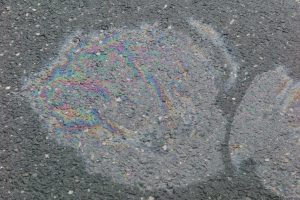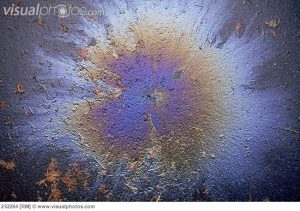
Oil and water might not mix, but if you place a small drop of oil on wet pavement you will get a symphony of color. You’ll find oil slicks, like the picture above, on roads after it rains.
The physics behind these colors is also the physics behind the colors of butterflies and other iridescent insects:
Since oil and water don’t mix a thin film of oil develops on top of the wet pavement. Whenever light travels from one medium to another (air to glass for example) some reflects and some is transmitted. In this case we have two places where light is reflected: some is reflected at the air/oil interface and some is reflected at the oil/water interface. If the thickness of the oil layer is equal to an integer multiple of the wavelength of light then the two reflected parts add up (constructively interfere); if it is equal to a half integer multiple the two reflected parts cancel (destructively interfere). Therefore, the color of the slick tells us something about the thickness of the film of oil! The bluer parts are thinner (~400 nm), the reder parts are thicker (~700 nm), and finally when the slick becomes even thicker it appears a silvery-white!

A nearly circular oil slick
Looking at the above picture we can see that the oil slick is thinnest at the center gets thicker as we move outward…. Although, as I write that, it seems weird to me. If we imagine a drop of oil on water it beads up- with the thickest part in the center! It would be fascinating to understand why this thin slick seems to have the opposite behavior.
Recent Comments